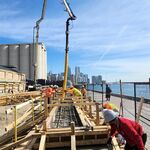Neutrino
Senior Member
Basically, the city is supposed to house 1 million more people, that's great, but the question I have is WHERE lol
And transport them all to work
Basically, the city is supposed to house 1 million more people, that's great, but the question I have is WHERE lol
Basically, the city is supposed to house 1 million more people, that's great, but the question I have is WHERE lol
Yes, that is especially evident based on the number of threads in the buildings section on here. ?Roughly the same place as the last half million went. 416 hasn't had significant greenfield expansion for a couple decades.
Nearly every big GTA greenfield developer of the 90's now has a well tuned condo development arm doing most of their business (by revenue).
Yes, that is especially evident based on the number of threads in the buildings section on here. ?
My comment was a bit rhetorical, but the underlying point is we need to rethink major parts of our planning status quo. For instance, our avenues have been designated for growth, and yet our mid-rise guidelines prohibits intensification along the avenues to the 8-14 storeys based on the avenue's ROW. This was sought for the purposes of enhancing the public realm, not for housing 1 million people. Meanwhile the areas adjacent to the avenues where only mid-rises are permitted, are largely "stable neighbourhoods" and are not designated for growth.
Relaxing standards along the avenues (e.g. allowing high-rises but ensuring that podiums fulfill public realm enhancement objectives) or opening up the stable neighbourhoods behind the avenues would go a long way towards housing that 1 million people, in a way that can be serviced by transit.
Those Yellowbelt Areas were more densely populated just a few decades ago, as many houses used to have more persons-per-household or included basement or 3rd-storey suites. Since then, throughout the Yellowbelt the owners either stopped renting basements, stopped having children, or sold to someone building a McMansion. Most stable neighbourhoods were built to accommodate services serving a population greater than exists in those same areas today, that is why in some neighbourhoods schools are under-capacity.Of course, that's hardly desired due to a lack of transit, road linkages, and in preserving the 'natural' feeling of the Yellow Belt, but there's definitely room for adaptation.
Yes, that is especially evident based on the number of threads in the buildings section on here. ?
My comment was a bit rhetorical, but the underlying point is we need to rethink major parts of our planning status quo. For instance, our avenues have been designated for growth, and yet our mid-rise guidelines prohibits intensification along the avenues to the 8-14 storeys based on the avenue's ROW. This was sought for the purposes of enhancing the public realm, not for housing 1 million people. Meanwhile the areas adjacent to the avenues where only mid-rises are permitted, are largely "stable neighbourhoods" and are not designated for growth.
Relaxing standards along the avenues (e.g. allowing high-rises but ensuring that podiums fulfill public realm enhancement objectives) or opening up the stable neighbourhoods behind the avenues would go a long way towards housing that 1 million people, in a way that can be serviced by transit.
Canada's population clock (real-time model)
This data visualization product provides information on the pace of population renewal in Canada. The web page shows a real-time model of population growth in Canada. The components of population growth are modelled in order to adjust the population of the country, provinces and territories...www150.statcan.gc.ca
Is the Greater Golden Horseshoe poised to overtake Greater London?





